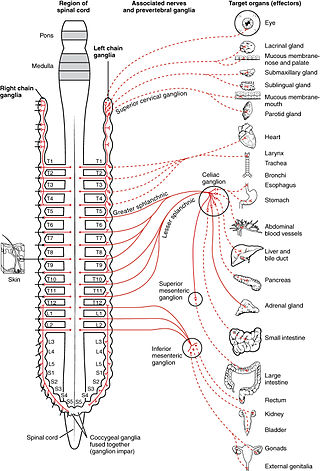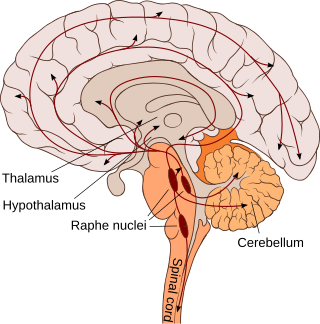Psychophysiology is the branch of psychology that is concerned with the physiological bases of psychological processes. While psychophysiology was a general broad field of research in the 1960s and 1970s, it has now become quite specialized, based on methods, topic of studies and scientific traditions. Methods vary as combinations of electrophysiological methods, neuroimaging, and neurochemistry. Topics have branched into subspecializations such as social, sport, cognitive, cardiovascular, clinical and other branches of psychophysiology.

The sympathetic nervous system (SNS) is one of the three divisions of the autonomic nervous system, the others being the parasympathetic nervous system and the enteric nervous system. The enteric nervous system is sometimes considered part of the autonomic nervous system, and sometimes considered an independent system.
Affective computing is the study and development of systems and devices that can recognize, interpret, process, and simulate human affects. It is an interdisciplinary field spanning computer science, psychology, and cognitive science. While some core ideas in the field may be traced as far back as to early philosophical inquiries into emotion, the more modern branch of computer science originated with Rosalind Picard's 1995 paper on affective computing and her book Affective Computing published by MIT Press. One of the motivations for the research is the ability to give machines emotional intelligence, including to simulate empathy. The machine should interpret the emotional state of humans and adapt its behavior to them, giving an appropriate response to those emotions.

The E-Meter is an electronic device used in Scientology that allegedly "registers emotional reactions". After claims by L. Ron Hubbard that the procedures of auditing, which used the E-Meter, could help heal diseases, the E-Meter became the subject of litigation. Since then, the Church of Scientology publishes disclaimers declaring that the E-Meter "by itself does nothing", is incapable of improving health, and is used solely for spiritual purposes.
Acute stress reaction and acute stress disorder (ASD) is a psychological response to a terrifying, traumatic or surprising experience. Combat stress reaction (CSR) is a similar response to the trauma of war. The reactions may include but are not limited to intrusive or dissociative symptoms, and reactivity symptoms such as avoidance or arousal. It may be exhibited for days or weeks after the traumatic event. If the condition is not correctly addressed, it may develop into post-traumatic stress disorder (PTSD).

The main concepts of the Cannon–Bard theory are that emotional expression results from the function of hypothalamic structures, and emotional feeling results from stimulations of the dorsal thalamus. The physiological changes and subjective feeling of an emotion in response to a stimulus are separate and independent; arousal does not have to occur before the emotion. Thus, the thalamic region is attributed a major role in this theory of emotion. The theory is therefore also referred to as the thalamic theory of emotion.

A biosignal is any signal in living beings that can be continually measured and monitored. The term biosignal is often used to refer to bioelectrical signals, but it may refer to both electrical and non-electrical signals. The usual understanding is to refer only to time-varying signals, although spatial parameter variations are sometimes subsumed as well.
Sudomotor function refers to the autonomic nervous system control of sweat gland activity in response to various environmental and individual factors. Sweat production is a vital thermoregulatory mechanism used by the body to prevent heat-related illness as the evaporation of sweat is the body’s most effective method of heat reduction and the only cooling method available when the air temperature rises above skin temperature. In addition, sweat plays key roles in grip, microbial defense, and wound healing.
A Bioamplifier is an electrophysiological device, a variation of the instrumentation amplifier, used to gather and increase the signal integrity of physiologic electrical activity for output to various sources. It may be an independent unit, or integrated into the electrodes.

Frisson, also known as aesthetic chills or psychogenic shivers, is a psychophysiological response to rewarding stimuli that often induces a pleasurable or otherwise positively-valenced affective state and transient paresthesia, sometimes along with piloerection and mydriasis . The sensation commonly occurs as a mildly to moderately pleasurable emotional response to music with skin tingling; piloerection and pupil dilation not necessarily occurring in all cases.

The axon reflex is the response stimulated by peripheral nerves of the body that travels away from the nerve cell body and branches to stimulate target organs. Reflexes are single reactions that respond to a stimulus making up the building blocks of the overall signaling in the body's nervous system. Neurons are the excitable cells that process and transmit these reflex signals through their axons, dendrites, and cell bodies. Axons directly facilitate intercellular communication projecting from the neuronal cell body to other neurons, local muscle tissue, glands and arterioles. In the axon reflex, signaling starts in the middle of the axon at the stimulation site and transmits signals directly to the effector organ skipping both an integration center and a chemical synapse present in the spinal cord reflex. The impulse is limited to a single bifurcated axon, or a neuron whose axon branches into two divisions and does not cause a general response to surrounding tissue.
Emotional responsivity is the ability to acknowledge an affective stimuli by exhibiting emotion. It is a sharp change of emotion according to a person's emotional state. Increased emotional responsivity refers to demonstrating more response to a stimulus. Reduced emotional responsivity refers to demonstrating less response to a stimulus. Any response exhibited after exposure to the stimulus, whether it is appropriate or not, would be considered as an emotional response. Although emotional responsivity applies to nonclinical populations, it is more typically associated with individuals with schizophrenia and autism.
Physioeconomics is an extension of experimental economics research that collects physiological parameters in addition to recording behavior. These measures can include skin conductance, blood pressure and the pulse of the subject. Experiments typically present subjects with economic decisions in a game–like context.
Emotional lateralization is the asymmetrical representation of emotional control and processing in the brain. There is evidence for the lateralization of other brain functions as well.
The James–Lange theory is a hypothesis on the origin and nature of emotions and is one of the earliest theories of emotion within modern psychology. It was developed by philosopher John Dewey and named for two 19th-century scholars, William James and Carl Lange. The basic premise of the theory is that physiological arousal instigates the experience of emotion. Previously people considered emotions as reactions to some significant events or their features, i.e. events come first, and then there is an emotional response. James-Lange theory proposed that the state of the body can induce emotions or emotional dispositions. In other words, this theory suggests that when we feel teary, it generates a disposition for sad emotions; when our heartbeat is out of normality, it makes us feel anxiety. Instead of feeling an emotion and subsequent physiological (bodily) response, the theory proposes that the physiological change is primary, and emotion is then experienced when the brain reacts to the information received via the body's nervous system. It proposes that each specific category of emotion is attached to a unique and different pattern of physiological arousal and emotional behaviour in reaction due to an exciting stimulus.
Body reactivity is usually understood as an organism's functional ability of its body to react adequately in response to influence the environment. It is not to be confused with resistance, which is its physiological stability against the influence of pathogenic factors. The body reactivity can range from homeostasis to a fight or flight response. Ultimately, they are all governed by the nervous system.
Psychophysiological economics is a field of study focused on the assessment and evaluation of psychological and physiological events as factors shaping consumer economic behavior. Psychophysiological economists believe that behavior and cognitive processing are indivisible and that behavioral, cognitive, and physiological tools and techniques can be combined to create interventions that improve the economic well-being of consumers.
Roland Clark Davis was an American psychologist recognized for his innovation in instrumentation and measurement of electrophysiological phenomena. Davis contributed to the measurement of electrodermal activity, gastric reflexes, and muscle action potentials. Davis published over 70 articles on psychophysiology and related topics across a 30-year career and mentored many graduate students at Indiana University Bloomington from 1931 through 1961.

Ioannis Thomas Pavlidis is a Greek American scholar. He is the distinguished Eckhard-Pfeiffer Professor of Computer Science at the University of Houston, founder, and director of the Affective and Data Computing Laboratory, formerly known as the Computational Physiology Lab (CPL).
Electrochemical skin conductance (ESC) is an objective, non-invasive and quantitative electrophysiological measure of skin conductance through the application of a pulsating direct current on the skin. It is based on reverse iontophoresis and steady chronoamperometry. ESC is intended to provide insight into and assess sudomotor function and small fiber peripheral neuropathy. The measure was principally developed by Impeto Medical to diagnose cystic fibrosis from historical research at the Mayo Clinic and then tested on others diseases with peripheral neuropathic alterations in general. It was later integrated into health connected scales by Withings.







